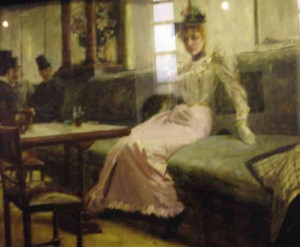
It’s a must-see for every serious culture-loving Filipino or just about anyone interested to know more about this republic with a long colonial history.
If the Louvre has the “Mona Lisa” with many stories attached to it, the National Museum also has “Parisian Life,” the once controversial painting acquired by the Government Service Insurance System (GSIS). During an 27 October 2002 Christie’s auction, the oil on canvas by Juan Luna (1857-1899) that was initially estimated to be worth $231,921- $257,690 garnered an actual price of $859,924. The painting came from one of the descendants of the original owner, Dr. Ariston Bautista Lin, whose image was believed to be included in the painting itself.
There are varied interpretations of the painting, including certain popular historical versions that capture the imagination of art aficionados. The three men in the picture are said to be Dr. Jose Rizal, Dr. Ariston Lin, and Juan Luna who were friends actively involved in the Philippine revolution. The Caucasian woman, languishing by the couch, represents the Philippines. The overall shape of the woman including shades and nuances reflect the Philippine map and the lady’s overall stiffness around the neck captures the country’s tense situation. Other elements such as a gentleman’s coat and a half-filled glass of liquor surrounding the woman may suggest that someone desires to take advantage of her.
This painting, that only won a silver Medal in the 1904 St. Louis Exposition after the death of Juan Luna, was completed before the three gentlemen returned to the Philippines where tumultuous historical events followed.
From the original acquisition cost of about P46 million, the painting is now reportedly worth about P200 million. The GSIS museum acquired fame upon the exhibition of the painting that was given “rock star status” for attracting around 200,000 visitors annually. As the GSIS struggled with managing its finances, the idea of re-selling the artwork surfaced. As per a news report, however, the board of trustees with President and General Manager Robert Vergara decided to entrust its art collection to the National Museum having concluded that “preserving and maintaining an art collection is beyond the mandate of the GSIS….” Since last year, the National Museum has been in possession of a noteworthy collection from the GSIS.
Nevertheless, first-time visitors to the museum will be drawn first to Juan Luna’s most valuable work and largest oil on canvas in the Philippines (4.22 meters x 7.675 meters). The “Spoliarium,” a Latin word (often misspelled as Spolarium) that refers to the basement of the Roman Colosseum where dying gladiators are thrown, won a gold medal at the well-known Exposicion de Bellas Artes (Madrid Art Exposition, May 1884).
During a speech delivered by Dr. Jose Rizal upon the painting’s triumph, he gave an interpretation that also seemed to allude to his Filipino countrymen’s plight. “In Spoliarium, on that canvas which is not mute, is heard the tumult of the throng, the cry of slaves, the metallic rattle of the armor on the corpses, the sobs of the orphans, the hums of prayers, with as much force and as realism as is heard in the crash of the thunder, amid roar of the cataracts, or in the fearful and frightful rumble of the earthquake. The same nature that conceives such phenomena has also a share in those lines.”
Right across the Luna masterpiece is another huge painting by Felix Hidalgo entitled “La Tragedia de Gobernador Bustamante,” that was also declared a national cultural treasure and 
Notable sculptures by Isabelo Tampinco occupy one gallery. Other important fine artists include Fernando Amorsolo, Carlos Francisco, Federico Alcuaz, and others. The museum also features exhibits on archaeology and natural history (includes the bones of a giant sperm whale among others, that kids enjoy viewing).
While the Smithsonian has its Hope Diamond that some believe to have carried a curse to those who possessed it, the National Museum has a similar little known story about another Luna painting known as “Mi Novia” believed by many to be the image of his wife Paz Pardo de Tavera (historian Ambeth Ocampo questioned this assumption).
In his book “Looking Back,” Ocampo relates: “Inquiring into the provenance of this painting, I could not understand why it has survived to the present, when the Pardo de Taveras are said to have burned all their Lunas….Tsismis says its first owner, Manuel Garcia, was forced to sell it because his business had gone bad. Betty Bantug Benitez bought it and met a tragic road accident in Tagaytay. The portrait then passed through the collection of Tony Nazareno, who also suffered bad luck and sudden illness, so he sold it to Imee Marcos Manotoc, who suffered a miscarriage. In the Luna-Hidalgo exhibition catalogue published by the Metropolitan Museum, the provenance given is not Imee Marcos, but Imelda Marcos, whose fate in 1986 we are all familiar with. She donated the painting to the National Museum.”
The backdrop for these new art collections involve major renovation work that was started some two years ago and is in its final stages. The museum houses its galleries in two separate buildings and it is a good idea to devote at least a half or whole day for such visits. While admission to the museum is free on Sundays (during regular days, P150 for adults), the collections are best appreciated with the help of an experienced guide or preliminary research work given the myriad details that accompany the art pieces.
It is easy to walk around, get lost in a sea of seemingly meaningless or unrelated objects. But with some advance reading and planning, a trip to the National Museum can become an enriching Filipino experience to be cherished for years to come.
ABOVE are two of the museum’s priceless pieces of art. photos by Ma. Esther Salcedo-Posadas

